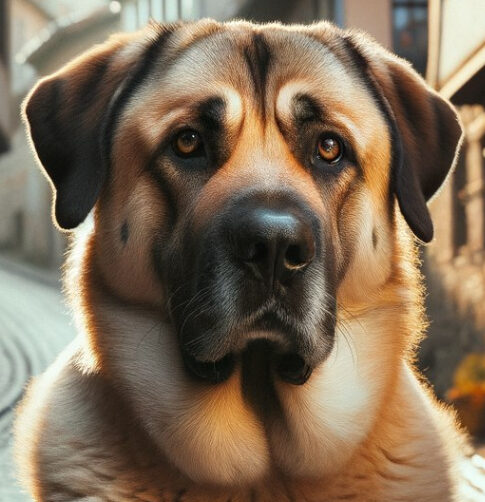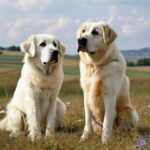Introduction
Turkish Malak dogs, also known as Kangal Shepherd Dogs, are a breed native to the Sivas province of Turkey. These majestic canines have a long and rich history, serving as loyal guardians and companions to shepherds and their flocks for centuries. With their imposing size, distinctive features, and gentle yet protective nature, Turkish Malak dogs have captured the hearts of dog enthusiasts worldwide. When it comes to dog breeds that embody strength, loyalty, and a rich cultural heritage, the Turkish Malak dog stands out. Known for their impressive stature and affectionate nature, these dogs have captured the hearts of many dog lovers around the world. In this guide, we’ll delve into everything you need to know about the Turkish Malak dog, from their historical roots to their care requirements. Whether you’re considering adding one of these majestic dogs to your family or simply want to learn more about them, this guide is tailored just for you.
What are Turkish Malak Dogs?
Turkish Malak dogs, often referred to simply as “Malaks,” are a large breed known for their impressive size and strong build. Originating from Turkey, these dogs were traditionally used as livestock guardians due to their protective instincts and intelligence. With a well-defined muscular structure and a thick coat that varies in color, they are not only striking in appearance but also versatile in their roles as companions or working dogs.One of the defining features of the Turkish Malak is its loyalty. They form strong bonds with their families and are known to be particularly affectionate with children. This breed thrives on companionship and is happiest when included in family activities. Their natural guarding instincts make them excellent watchdogs, always alert to any potential threats.
History and Origin of Turkish Malak Dogs
The history of the Turkish Malak dog is deeply intertwined with the pastoral lifestyle of Turkey’s nomadic tribes. These dogs were bred primarily for herding and protecting livestock from predators such as wolves and bears. Their lineage can be traced back several centuries, making them one of the oldest breeds in the region.As Turkey modernized, the role of the Malak evolved from a working dog to a beloved family pet. Despite this shift, they have retained many of their original traits—such as loyalty, intelligence, and a strong protective instinct—making them a popular choice among those looking for both companionship and security.
Physical Characteristics of Turkish Malak Dogs
Turkish Malak dogs are known for their impressive size and muscular build. Males typically stand between 28 and 31 inches tall at the shoulder, while females range from 26 to 29 inches.
These dogs are well-proportioned, with a broad head, triangular ears, and a thick, muscular neck. Their coat is short and dense, with a variety of colors including fawn, brindle, and white.One of the most distinctive features of Turkish Malak dogs is their unique mask-like markings around the eyes and muzzle.
These markings, known as “karakaş,” are highly prized by breeders and enthusiasts alike. The breed also has a distinctive double dewclaw on each hind leg, which is a genetic trait that sets them apart from other breeds.
Temperament and Personality
Turkish Malak dogs are known for their unwavering loyalty, intelligence, and affectionate nature.
These dogs form strong bonds with their families and are fiercely protective of their loved ones.
They are gentle with children and make excellent family companions, but their size and strength require responsible ownership and early socialization.Despite their imposing appearance, Turkish Malak dogs are typically calm and well-behaved in the home.
They are highly trainable and respond well to positive reinforcement techniques. These dogs are also adaptable to different living environments, making them suitable for both urban and rural settings.
Grooming and Care
Maintaining the health and appearance of a Turkish Malak dog requires regular grooming. These dogs have a short, dense coat that sheds moderately throughout the year. Brushing once or twice a week can help remove loose hair and keep their coat looking its best.
Bathing should be done as needed, typically every few months or when the dog becomes dirty. It’s important to use a gentle, dog-safe shampoo and to thoroughly rinse the coat to prevent skin irritation. Nail trimming and ear cleaning should be done regularly to prevent infections and discomfort.
Health and Lifespan
Turkish Malak dogs are generally healthy, with a lifespan of 10 to 12 years. However, like all breeds, they are susceptible to certain health conditions. Some common issues include hip and elbow dysplasia, gastric torsion (bloat), and eye problems such as entropion and ectropion.
To ensure the health and longevity of your Turkish Malak dog, it’s essential to provide regular veterinary check-ups, preventive care, and vaccinations. A balanced diet and appropriate exercise are also crucial for maintaining their overall well-being.
Feeding and Nutrition
Turkish Malak dogs require a high-quality, protein-rich diet to support their large size and active lifestyle. Puppies should be fed a diet specifically formulated for large-breed puppies to support their growth and development. Adult dogs can be fed a combination of high-quality dry kibble and wet food, with portion sizes adjusted based on their age, activity level, and individual needs.It’s important to provide clean, fresh water at all times and to avoid feeding table scraps or human food, as these can lead to digestive issues and obesity. Consult with your veterinarian or a canine nutritionist to determine the best feeding plan for your Turkish Malak dog.
Exercise and Activity Needs
Turkish Malak dogs are active and energetic, requiring regular exercise to maintain their physical and mental well-being. These dogs thrive on a combination of daily walks, playtime in a secure yard, and mentally stimulating activities such as obedience training and puzzle toys. A fenced-in yard is ideal for Turkish Malak dogs, as they enjoy having space to run and play. However, it’s essential to ensure that the yard is secure and that the dog is supervised to prevent potential escapes or interactions with unfamiliar animals.
Training and Socialization
Early socialization and training are crucial for Turkish Malak dogs to develop into well-rounded, well-behaved companions. These dogs respond best to positive reinforcement techniques, such as treats, praise, and clicker training. It’s important to establish yourself as a calm, confident leader and to be consistent with training to ensure the best results. Basic obedience commands, such as sit, stay, come, and heel, should be taught from an early age.
Advanced training, such as agility or herding, can also be a great way to bond with your Turkish Malak dog and provide mental stimulation.
Choosing a Turkish Malak Dog
If you’re considering adding a Turkish Malak dog to your family, it’s essential to do your research and find a reputable breeder or adoption organization. Look for breeders who prioritize health, temperament, and the well-being of their dogs. When selecting a puppy, consider factors such as the puppy’s temperament, socialization, and overall health. Before bringing your new furry friend home, make sure to prepare your living space by providing a comfortable bed, secure toys, and a designated potty area. It’s also important to introduce your new dog to your family members and any other pets gradually and in a controlled environment to ensure a smooth transition.
Common Myths about Turkish Malak Dogs
Despite being beloved by many owners worldwide there exist several misconceptions surrounding this breed:
- Myth 1: They are aggressive towards strangers.
- While protective by nature proper socialization can mitigate this behavior.
- Myth 2: They require extensive grooming.
- Their short coat requires minimal grooming compared to other breeds.
- Myth 3: They cannot adapt well indoors.
- With enough exercise & mental stimulation they can thrive indoors too!
Understanding these myths helps potential owners make informed decisions regarding adopting or caring for one!
You can also read-
- Anatolian Shepherd Dog Health Tips and Common Health Issues
- How the Anatolian Shepherd Dog Protects Livestock: The Ultimate Guardian of Flocks
FAQs
1- Are Turkish Malak dogs good with children?
Turkish Malak dogs are known for their gentle and patient nature with children. However, it’s essential to supervise interactions and teach children how to approach and interact with the dog respectfully.
2- Do Turkish Malak dogs require a lot of grooming?
While Turkish Malak dogs have a short, dense coat, they do require regular brushing to remove loose hair and keep their coat looking its best. Bathing should be done as needed, typically every few months.
3- Are Turkish Malak dogs easy to train?
Turkish Malak dogs are highly intelligent and respond well to positive reinforcement training techniques. Early socialization and consistent training are essential for developing a well-behaved companion.
4- What is the average lifespan of a Turkish Malak dog?
Turkish Malak dogs have an average lifespan of 10 to 12 years. Providing a balanced diet, regular exercise, and preventive veterinary care can help extend their lifespan and maintain their overall health.
5-Do Turkish Malak dogs require a lot of exercise?
Turkish Malak dogs are active and energetic, requiring regular exercise to maintain their physical and mental well-being. Daily walks, playtime in a secure yard, and mentally stimulating activities are essential for keeping these dogs happy and healthy.
6- Are Turkish Malak dogs hypoallergenic?
No, Turkish Malak dogs are not hypoallergenic. Their short, dense coat sheds moderately throughout the year, which may trigger allergic reactions in some individuals.
Conclusion
Turkish Malak dogs are a breed that embodies loyalty, intelligence, and affection. With their impressive size, distinctive features, and gentle nature, these dogs make wonderful companions for families and individuals alike. By providing proper care, training, and socialization, Turkish Malak dogs can thrive and bring joy to their owners for many years to come.

